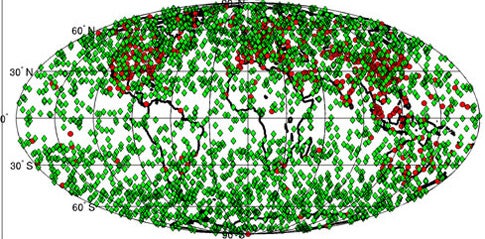The accuracy of weather forecasts may improve given the April 14 launch of six satellites. COSMIC (Constellation Observing System for Meteorology, Ionosphere and Climate), which rocketed into low Earth orbit from Vandenberg Air Force Base, California, will provide real-time atmospheric data for thousands of points on Earth. The array is the first to provide global coverage, and the information it collects will help scientists predict weather as well as study long-term climate change.
The suite of six satellites will collect data via radio occultations, or interference, of 24 U.S. Global Positioning System (GPS) satellite signals. Molecules in Earth’s atmosphere alter the amplitude and frequency of GPS signals. By measuring the amount of distortion, scientists can determine characteristics like air density, temperature, and moisture. Together, the satellites collect approximately 2,500 measurements daily, which nearly triples the amount of real-time data available to researchers.
Three ground-based stations — in Fairbanks, Alaska; Kiruna, Sweden; and Taiwan — monitor and control the satellites and downlink the data — they have received signals that all six satellites are working. Two data centers — in Boulder, Colorado, and Taiwan — maintain an online archive with information available to scientists within hours of the data collection. The $100 million project is a partnership among agencies in Taiwan and the United States. In Taiwan, the array is called FORMOSAT-3.












